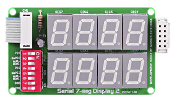 |

|
|
7seg click is an accessory board in mikroBUS form factor. It's a compact and easy solution for adding a 2-digit seven-segment display to your device. It features two 74HC595 8-bit serial-in, parallel-out shift register modules as well as two seven-segment digits. 7seg Click communicates with target boards via an SPI interface. It has a green LED which indicates the presence of power. An SMD jumper is available for selecting whether the board will be operating on a 3.3V or 5V power supply. |
|
|
|
 |

|
|
The Serial 7-seg Display Board features the MAX7219 compact, serial input/output, common-cathode display driver - used to interface MCUs to 7-segment numeric LED displays via SPI interface. The chip includes a BCD code-B decoder, multiplex scan circuitry, segment and digit drivers and 8x8 static RAM for storing digits. Display drivers are connected to 4 common-cathode LED displays. The board features four 7-segment digits arranged in a single row. |
|
|
|
 |

|
|
The Serial 7-seg Display 2 Board enables you to use a 7-segment LED display. It features an on-board SPI interface, LED display driver MAX7219 and 8 common-cathode LED displays. The board is connected to a device via an on-board IDC10 connector. |
|
|
|
 |

|
|
The Serial 7-seg Display - 8-Digit Board features the MAX7219 compact, serial input/output, common-cathode display driver - used to interface MCUs to 7-segment numeric LED displays via SPI interface. The chip includes a BCD code-B decoder, multiplex scan circuitry, segment and digit drivers and 8x8 static RAM for storing digits. Display drivers are connected to 8 common-cathode LED displays. The board features eight 7-segment digits arranged in a single row. |
|
|
|
 |

|
|
AlphaNum click is a simple solution for adding 14-segment alphanumeric display to your device. The board carries two TLC5926 16-bit Constant-Current LED sink Drivers as well as a dual character green or red LED 14-segment display (with two additional segments for commas). AlphaNum click communicates with the target board through mikroBUS RST, CS, SCK, MISO, MOSI, PWM and INT pins (marked here as LE2, LE1, CLK, DOUT, DIN, NUMSEL and NUMSEL respectively). The board is designed to use either a 3.3V or 5V power supply.
|
|
|
|
 |
|

